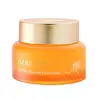What's inside
What's inside
 Key Ingredients
Key Ingredients

 Benefits
Benefits

 Concerns
Concerns

 Ingredients Side-by-side
Ingredients Side-by-side

Water
Skin ConditioningGlycerin
HumectantCyclopentasiloxane
EmollientDimethicone
EmollientButylene Glycol
HumectantNiacinamide
SmoothingPEG-240/Hdi Copolymer Bis-Decyltetradeceth-20 Ether
StabilisingCalendula Officinalis Flower Extract
MaskingSilica
AbrasivePanthenol
Skin ConditioningPalmitoyl Tripeptide-5
Skin ConditioningPalmitoyl Tripeptide-1
Skin ConditioningPalmitoyl Tetrapeptide-7
Skin ConditioningCopper Tripeptide-1
Skin ConditioningAcetyl Hexapeptide-8
HumectantPentylene Glycol
Skin ConditioningAminobutyric Acid
Bis-PEG-18 Methyl Ether Dimethyl Silane
EmollientCaprylyl Glycol
EmollientPolysilicone-11
Raffinose
Skin ConditioningTocopheryl Acetate
AntioxidantPEG-9 Polydimethylsiloxyethyl Dimethicone
EmulsifyingCarbomer
Emulsion StabilisingVinyl Dimethicone/Methicone Silsesquioxane Crosspolymer
Tromethamine
BufferingHydrogenated Lecithin
Emulsifying1,2-Hexanediol
Skin ConditioningGlyceryl Acrylate/Acrylic Acid Copolymer
HumectantDisodium EDTA
Tocopherol
AntioxidantPotassium Laurate
EmulsifyingEthylhexylglycerin
Skin ConditioningColloidal Gold
AntimicrobialAloe Barbadensis Leaf Extract
EmollientPolysorbate 20
EmulsifyingBiotin
AntiseborrhoeicCyanocobalamin
Skin ConditioningAscorbyl Tetraisopalmitate
AntioxidantPyridoxine Hcl
Skin ConditioningLinoleic Acid
CleansingHexylene Glycol
EmulsifyingDecylene Glycol
Skin ConditioningOleic Acid
EmollientTotarol
AntioxidantPalmitic Acid
EmollientStearic Acid
CleansingLinolenic Acid
CleansingPhenoxyethanol
PreservativeWater, Glycerin, Cyclopentasiloxane, Dimethicone, Butylene Glycol, Niacinamide, PEG-240/Hdi Copolymer Bis-Decyltetradeceth-20 Ether, Calendula Officinalis Flower Extract, Silica, Panthenol, Palmitoyl Tripeptide-5, Palmitoyl Tripeptide-1, Palmitoyl Tetrapeptide-7, Copper Tripeptide-1, Acetyl Hexapeptide-8, Pentylene Glycol, Aminobutyric Acid, Bis-PEG-18 Methyl Ether Dimethyl Silane, Caprylyl Glycol, Polysilicone-11, Raffinose, Tocopheryl Acetate, PEG-9 Polydimethylsiloxyethyl Dimethicone, Carbomer, Vinyl Dimethicone/Methicone Silsesquioxane Crosspolymer, Tromethamine, Hydrogenated Lecithin, 1,2-Hexanediol, Glyceryl Acrylate/Acrylic Acid Copolymer, Disodium EDTA, Tocopherol, Potassium Laurate, Ethylhexylglycerin, Colloidal Gold, Aloe Barbadensis Leaf Extract, Polysorbate 20, Biotin, Cyanocobalamin, Ascorbyl Tetraisopalmitate, Pyridoxine Hcl, Linoleic Acid, Hexylene Glycol, Decylene Glycol, Oleic Acid, Totarol, Palmitic Acid, Stearic Acid, Linolenic Acid, Phenoxyethanol
Water
Skin ConditioningGlycerin
HumectantStearic Acid
CleansingMyristic Acid
CleansingPotassium Hydroxide
BufferingLauric Acid
CleansingCocamidopropyl Betaine
CleansingHydrogenated Castor Oil
EmollientPolyquaternium-7
Propylene Glycol
HumectantPEG-7 Glyceryl Cocoate
EmulsifyingGlyceryl Stearate
EmollientPEG-100 Stearate
Lauryl Glucoside
CleansingCaprylyl/Capryl Glucoside
CleansingSodium Cocoyl Glycinate
CleansingLactic Acid
BufferingButylene Glycol
HumectantPunica Granatum Fruit Extract
AntioxidantPhenoxyethanol
PreservativeHydroxypropyl Methylcellulose
Emulsion StabilisingMethylparaben
PreservativeDisodium EDTA
Parfum
MaskingWater, Glycerin, Stearic Acid, Myristic Acid, Potassium Hydroxide, Lauric Acid, Cocamidopropyl Betaine, Hydrogenated Castor Oil, Polyquaternium-7, Propylene Glycol, PEG-7 Glyceryl Cocoate, Glyceryl Stearate, PEG-100 Stearate, Lauryl Glucoside, Caprylyl/Capryl Glucoside, Sodium Cocoyl Glycinate, Lactic Acid, Butylene Glycol, Punica Granatum Fruit Extract, Phenoxyethanol, Hydroxypropyl Methylcellulose, Methylparaben, Disodium EDTA, Parfum
Ingredients Explained
These ingredients are found in both products.
Ingredients higher up in an ingredient list are typically present in a larger amount.
Butylene Glycol (or BG) is used within cosmetic products for a few different reasons:
Overall, Butylene Glycol is a safe and well-rounded ingredient that works well with other ingredients.
Though this ingredient works well with most skin types, some people with sensitive skin may experience a reaction such as allergic rashes, closed comedones, or itchiness.
Learn more about Butylene GlycolDisodium EDTA plays a role in making products more stable by aiding other preservatives.
It is a chelating agent, meaning it neutralizes metal ions that may be found in a product.
Disodium EDTA is a salt of edetic acid and is found to be safe in cosmetic ingredients.
Learn more about Disodium EDTAGlycerin is already naturally found in your skin. It helps moisturize and protect your skin.
A study from 2016 found glycerin to be more effective as a humectant than AHAs and hyaluronic acid.
As a humectant, it helps the skin stay hydrated by pulling moisture to your skin. The low molecular weight of glycerin allows it to pull moisture into the deeper layers of your skin.
Hydrated skin improves your skin barrier; Your skin barrier helps protect against irritants and bacteria.
Glycerin has also been found to have antimicrobial and antiviral properties. Due to these properties, glycerin is often used in wound and burn treatments.
In cosmetics, glycerin is usually derived from plants such as soybean or palm. However, it can also be sourced from animals, such as tallow or animal fat.
This ingredient is organic, colorless, odorless, and non-toxic.
Glycerin is the name for this ingredient in American English. British English uses Glycerol/Glycerine.
Learn more about GlycerinPhenoxyethanol is a preservative that has germicide, antimicrobial, and aromatic properties. Studies show that phenoxyethanol can prevent microbial growth. By itself, it has a scent that is similar to that of a rose.
It's often used in formulations along with Caprylyl Glycol to preserve the shelf life of products.
Stearic Acid is a fatty acid. It is an emollient, emulsifier, and texture enhancer.
As an emollient, stearic acid helps soften skin. It aids the skin's protective barrier by preventing water loss. It also provides a gentle cleansing effect without stripping away natural oils.
Stearic acid may also be used to enhance the texture of products. It can add volume and stabilize ingredients such as water and oil. This can help water and oil ingredients from separating.
Sources of stearic acid include animal or vegetable fats/oils such as coconut or shea. It can be naturally found in butter, cocoa butter, shea butter, vegetable fats, and animal tallow.
This ingredient may not be Malassezia folliculitis, or fungal-acne safe.
Learn more about Stearic AcidWater. It's the most common cosmetic ingredient of all. You'll usually see it at the top of ingredient lists, meaning that it makes up the largest part of the product.
So why is it so popular? Water most often acts as a solvent - this means that it helps dissolve other ingredients into the formulation.
You'll also recognize water as that liquid we all need to stay alive. If you see this, drink a glass of water. Stay hydrated!
Learn more about Water